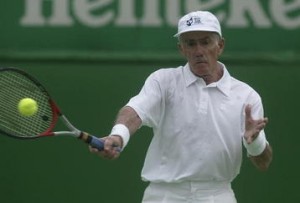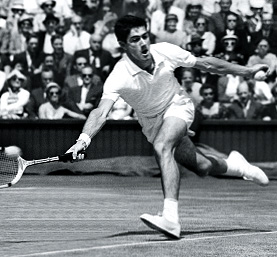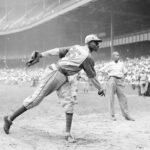Ken Rosewall: Star of a By-Gone Era

Ken Rosewall is still active as a tennis legend.In looking back at the great players of the past, I often can’t help but wonder how they’d perform in the modern game.
It might not have been as lucrative to be a pro tennis player in Ken Rosewall’s day, but there were other advantages.
For though it was a physically demanding sport even then, one didn’t necessarily have to be over six feet tall and ripped. While the modern men’s game has had only two major champions—the single slam winners Michael Chang and Gaston Gaudio—under 5’10”, Rosewall was actually under today’s average international height for males at 5’7″.
And while fitness has long been demanded of its players, Rosewall played in a day when a build like Rafael Nadal’s was unthinkable. Rosewall, actually, would acquire the nickname “Muscles” on the tennis court, but it was ironic moniker: The 145-pound Australian was given the name because muscles were something he didn’t have in abundance.
But Nadal and Rosewall do share kinship in one respect: The close relatives who taught them how to play the game instructed them to do so with their non-dominant arm. Toni Nadal’s decision to teach his nephew to play lefty has proven beneficial, as many a right-handed opponent has struggled to retrieve his high-bouncing shots to their backhands.
It’s a bit harder, though, to see how it benefited Ken Rosewall when his father, an avid player and tennis court owner, insisted that his son play right-handed. Perhaps there was no precedent for left-handed tennis greats in those days; all that is known is that, playing right-handed, Rosewall’s worst shots would be his forehand and serve.a
This is virtually unheard of since Ivan Lendl used his serving speed and overpowering forehand to win eight majors. Lendl’s influence has only grown over the years, and today everyone from world No. 1 and strong GOAT candidate Roger Federer to streakier threats like Robin Soderling and Tomas Berdych overpower opponents through a variation of the serve-and-forehand approach.
But Rosewall played in an age where “overpowering” opponents was less necessary. Rosewall’s one-handed backhand was one of the best the game has ever seen, his volleys were lethal despite his stature, and his movement was legendary: David Foster Wallace once said that Pete Sampras’ court coverage was similar to Rosewall’s in that the two men could seemingly “disappear and rematerialize” in perfect position for the next shot.

Rosewall won his final Grand Slam title at the age of 37.
Furthermore, though he played right-handed, he still had a lefty’s mind, so to speak: Like great southpaws John McEnroe and Rod Laver, he relied heavily on accuracy, feel, and disguise. In the era of wooden rackets, this was enough to carry a man to the top of the men’s game. When Rocket reached No. 1 just after Muscles did, one could only guess what kind of career Rosewall might have carved for himself playing with his “good” arm.
Because he carved out an awfully impressive CV with the other one.
Rosewall’s first trip to a major quarterfinal took place as an amateur at the ’52 U.S. Championships. Over the next few years he won the Australian Championships in 1953 and ’55, the French Championships in ’53 and the U.S. Championships in ’56. Along with his countryman, the explosive Lew Hoad, Rosewall captured all of the major doubles championships of 1956 except the French.
Then, at the end of 1956, Rosewall turned pro. A tennis tour was very different in those days: Rival players would sign up to play a long series of matches against one another, and a weaker rival could have his reputation devastated quickly, which would cause the whole sport to suffer loss of ticket sales.
Rosewall was not eased into the sport: He quickly signed into a deal with the reigning king of tennis, Ricardo Alonso “Pancho” Gonzales, to play a series.
As Gonzales had long been the world’s best player, dominating an assortment of very good pros including Tony Trabert and Frank Sedgman, tour promoter Jack Kramer at first feared that Rosewall would offer little competition and instructed Gonzales to “carry” the young Australian and keep the matches competitive.
This quickly proved unnecessary: Though he lost their series for 1957 by a margin of 50-26, by 1959 he was keeping pace with Gonzales, having beaten the big American in at least three of their five matches (some sources say it was actually five out of seven).
When the pros were integrated into the new World Pro tour in 1960, Gonzales reasserted his dominance but then suddenly retired (temporarily) that May. In his absence, Rosewall soon established himself as the game’s No. 1 player. By 1962, as Laver was sweeping the amateur circuit’s most prestigious titles, Rosewall was just as dominant in the pro game: He captured Wembley and Roland Garros, the two biggest events among professionals, and lost only eight matches all year.
When Laver turned pro, the two Australians quickly started a rivalry that would last through the start of the modern tour. At first Muscles got the better of the Rocket, winning 14 of 18 matches against Laver in 1963. By 1964 Laver began reversing their head-to-head meetings, but Rosewall edged him out for the No. 1 ranking.
By 1966, the two were on nearly even terms, with Rosewall winning nine tournaments overall and Laver 15, and the two splitting their head-to-head confrontations at 7-7. However, by 1967 Laver was undeniably the game’s best, sweeping the game’s five biggest events and topping Rosewall in eight of 13 confrontations.
However, one of the advantages of playing in those days was that one’s career was far from over once their career downturn began. As the Open Era dawned in 1968, the aging Muscles retained his clay court prowess, winning the French Open 15 years after taking his first French Championships title in ’53.
Though the early days of the Open Era are best known for Laver’s unprecedented second complete Grand Slam in 1969, the thirty-something Rosewall accomplished some rare feats of his own, capturing his second US title in 1970, and added his third and fourth in Australia in 1971-72.
He was still in contention for major titles as his fourth decade was drawing to a close, though competing over a two-week period proved increasingly difficult. In 1974, he reached his last two major finals at Wimbledon and the US Open. Though overpowered by Jimmy Connors’ voracious returns, Muscles had proved his staying power.
In fact, playing on the pro tour until age 40 was more common in those days, but still Rosewall’s longevity was staggering: He remained one of the game’s 20 best players for an awe-inspiring 26 years, finally dropping out of the top 20 in 1977. Though he gradually played less and less, he reached his last tour final at the New South Wales Hard Court Championships in 1982, when Muscles was 47.
Exact records were kept less faithfully by the ITF and ATP in those days, but Rosewall is known to have won at least 132 tournaments since his amateur career began, including eight Grand Slam singles titles.
He was inducted into the Hall of Fame in 1980. His home nation has since honored him as a Living Treasure and in early 2008 his backhand was selected by Tennis.com as part of its Greatest Shots in Tennis History series.
With its towering players, overwhelming pace, and short careers, tennis today seems only loosely related to the game that Rosewall excelled at for so long. But it owes a debt to him for him for having been there, one of those who carried the sport’s torch during its long development into the pro circuit we’re familiar with now.
A feat that’s all the more impressive, in that he carried it with the wrong arm all those years.













